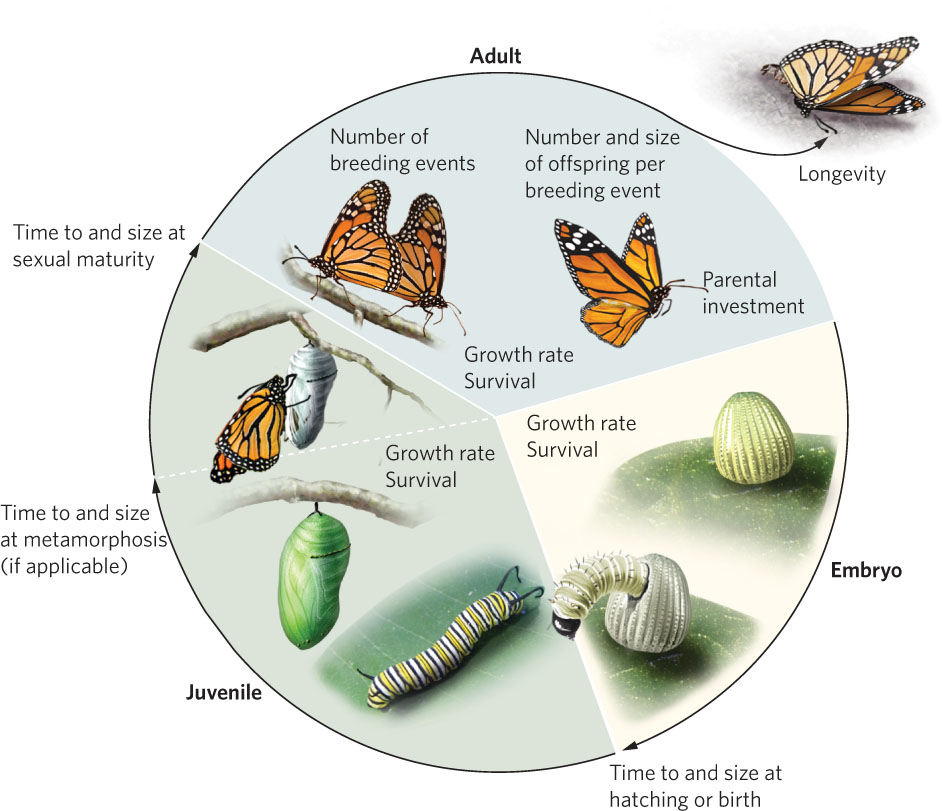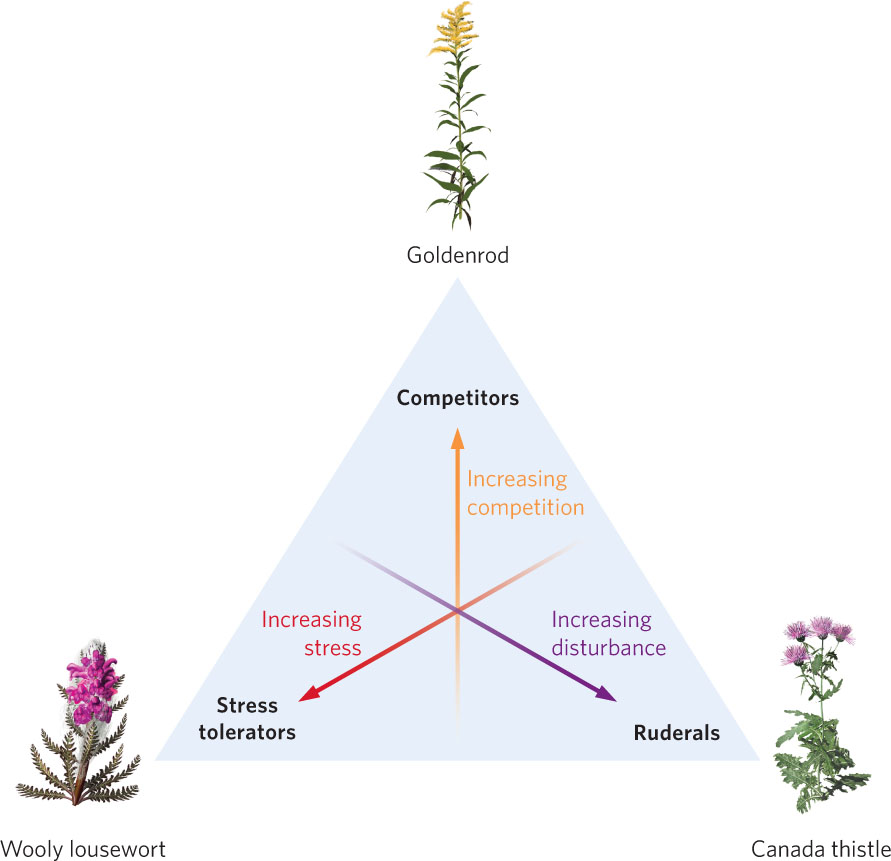Life history traits represent the schedule of an organism’s life
The schedule of an organism’s growth, development, reproduction, and survival makes up what ecologists call the life history of the organism. As you can see in Figure 8.1, the life history of an organism includes the traits connected to the birth or hatching of offspring. These include the time required to reach sexual maturity; fecundity, which is the number of offspring produced per reproductive episode; parity, which is the number of episodes of reproduction; parental investment, which is the amount of time and energy given to offspring; and longevity, or life expectancy, which is the life span of an organism. In essence, life history traits describe an organism’s strategy for obtaining evolutionary fitness throughout its lifetime. In addition, life history traits represent the combined effect of many morphological, behavioral, and physiological adaptations of organisms, all of which interact with environmental conditions to affect survival, growth, and reproduction. In this section, we will explore the wide range of life traits that exist in nature and how these traits are often organized into strategies that allow organisms to persist under different ecological conditions.

Life history The schedule of an organism’s growth, development, reproduction, and survival.
Fecundity The number of offspring produced by an organism per reproductive episode.
Parity The number of reproductive episodes an organism experiences.
Parental investment The amount of time and energy given to an offspring by its parents.
Longevity The life span of an organism. Also known as Life expectancy.
The Slow-To-Fast Life History Continuum
Life history traits vary widely among species and among populations within a species. An organism’s life history represents a solution to the problem of allocating limited time and resources to achieve maximum reproductive success. A remarkable fact about reproductive success is that the result is always nearly the same. On average, only one of the offspring that an individual produces lives to reproduce. In short, each individual only replaces itself. If this were not the case, populations would either dwindle to extinction because individuals fail to replace themselves or populations would continually expand.
187
How organisms grow and produce offspring varies in all imaginable ways. A female sockeye salmon, after swimming up to 5,000 km from her Pacific Ocean feeding ground to the mouth of a coastal river in British Columbia, still faces an upriver journey of 1,000 km to her spawning ground. There she lays thousands of eggs, and promptly dies, her body wasted from the exertion. A female African elephant gives birth to a single offspring at intervals of several years, lavishing intense care on her baby until it is old enough and large enough to fend for itself in the world of elephants. Thrushes, a group of birds that includes the American robin (Turdus migratorius), start to reproduce when they are 1 year old, and may produce several clutches—which are sets of eggs—each year, with each clutch containing three or four chicks. Adult thrushes rarely live beyond 3 or 4 years. In contrast, storm petrels, which are seabirds about the size of thrushes, do not begin to reproduce until they are 4 or 5 years old and then only rear a single chick each year. They may live for 30 or 40 years. This wide variation in life history traits among species has captured the interest of researchers who wish to understand ecological conditions that favor such disparate evolutionary outcomes.
Two points can be made about this variation. First, life history traits often vary consistently with respect to life form, habitat, or conditions in the environment. Seed size, for example, is generally larger for trees than for grasses. Second, variation in one life history trait is often correlated with variation in other life history traits. For example, the number of offspring produced during a single breeding event is often negatively correlated with the size of the offspring. As a result, variations in many life history traits can be organized along a continuum of values.
We can refer to one extreme as the “slow” end of the spectrum. At this extreme, organisms such as elephants, albatrosses, giant tortoises, and oak trees require a long time to reach sexual maturity. They commonly have long life spans, low numbers of offspring, and a high parental investment in the energy given to their offspring, such as parental care, the amount of yolk in an egg, or the amount of energy stored in a seed. At the fast end of the spectrum are organisms such as fruit flies and herbaceous weedy plants, which exhibit short times to sexual maturity, high numbers of offspring, little parental investment, and short life spans.
Combinations of Life History Traits in Plants
The English ecologist J. Philip Grime conceptualized the relationship between the life history traits and environmental conditions as a triangle, with each of the three points representing an extreme condition. As shown in Figure 8.2, the environmental conditions he considered were stress, competition, and the frequency of disturbances. Grime proposed that plants functioning at the extremes of these three axes possessed combinations of traits that could be categorized as stress tolerators, competitors, or ruderals. Table 8.1 lists some of the major differences in these three plant strategies.

THE LIFE HISTORY TRAITS OF PLANTS THAT ARE POSITIONED AT THE ENVIRONMENTAL EXTREMES OF STRESS, COMPETITION, AND DISTURBANCE
| LIFE HISTORY TRAITS | STRESS TOLERATORS | COMPETITORS | RUDERALS |
| POTENTIAL GROWTH RATE | Slow | Fast | Fast |
| AGE OF SEXUAL MATURITY | Late | Early | Early |
| PROPORTION OF ENERGY USED TO MAKE SEEDS | Low | Low | High |
| IMPORTANCE OF VEGETATIVE REPRODUCTION | Frequently important | Often important | Rarely important |
188
As their name implies, stress tolerators live under extreme environmental conditions, such as low water availability, very cold temperatures, or high salt concentrations. For example, plants living in the tundra biome, such as the wooly lousewort (Pedicularis dasyantha), are typically small herbs that live for many years, grow very slowly, and achieve sexual maturity relatively late in life. Similarly, many plants that live in the desert, such as cactus, are stress tolerators because they can survive long periods of hot temperatures with no precipitation. Because growing from a seed is very difficult in such stressful environments, they put little of their energy into seeds. Instead, they rely on vegetative reproduction, which is a form of asexual reproduction in which new plants develop from the roots and stems of existing plants.
189
Where conditions for plant growth are less stressful, plants can evolve life history traits that fall along a continuum from competitors to ruderals. With low stress and low frequency of disturbance, there is more competition. Competitors can grow relatively fast, achieve sexual maturity early in life, and devote a small proportion of their energy to seed production because they often spread by vegetative reproduction. Competitors also tend to grow large and exhibit long life spans. In forests, most species of trees fit the competitor category. In abandoned farm fields, a strong competitor is the group of tall herbaceous plants known as goldenrods.
At the other point of the triangle, with low stress and high frequency of disturbance, we find ruderals. These plants colonize disturbed patches of habitat, exhibit fast growth, early maturation, and use a high proportion of their energy to make seeds. Ruderals include many plants that we might call “weeds” in a garden, including dandelions (Taraxacum officinale), common ragweed (Ambrosia artemisiifolia), and Canada thistle (Cirsium arvense). Ruderals typically have seeds that are easily dispersed and that can persist in the environment for many years as they wait for favorable environmental conditions. This collection of traits allows ruderal plants to reproduce quickly and to disperse their seeds to other disturbed sites.